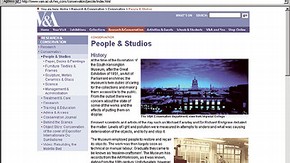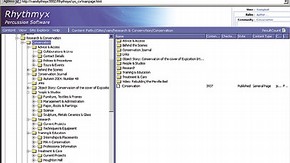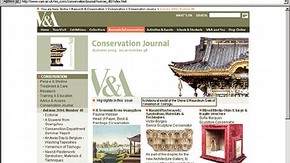Conservation Journal
Summer 2005 Issue 50
V&A Conservation on the world wide web: a secondment to the V&A web team
From 1 July 2003 to 31 January 2004 I was offered the chance to be a member of the V&A Web Team. My aim was to build the Conservation pages of the new V&A website. Web Team secondees frequently concentrated on creating microsites for specific projects, however I had always been keen to further develop the Conservation presence on the website.
Helen Armstrong from Records & Collections Services and I were to be the last secondees, as the Online Museum was already tendering for redesign of the entire V&A website and was setting up the new Content Management System (CMS), Rhythmyx, in preparation for the migration of the content from the old website design to the new (Figure 1).
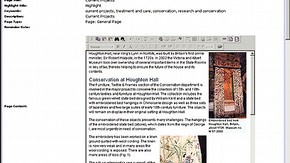
Figure 1: Rhythmyx: the new Content Management System for the V&A website (click image for larger version)
In simplest terms a content inputting program, Rhythmyx has replaced the use of a previous CMS, called MediaSurface, in V&A website creation and maintenance. It is intended to be gradually devolved across the Museum, eventually allowing representatives of departments to maintain their own areas of the new V&A website.
We spent July 2003 doing the excellent Adobe® Photoshop® and Macromedia® Dreamweaver® training that the secondment offers. The Photoshop training in particular was invaluable. A two day course covered all the basic settings, photographic image processing and manipulation, as well as processing for the web. These skills have also come in extremely useful post-secondment in assisting the conservators with images for condition reports and articles. After each course we had two days of 'consolidation' training with the Web Team back at the V&A. As part of this process, Helen and I put together an experimental microsite - The Ark - and filled it with ceramic animals from the collections. Aimed at a young audience, it even included an attempt at an interactive quiz, courtesy of Helen. We were very pleased with the result.
Initially we worked on a recently completed microsite called 'Behind the Scenes'. Originally designed and built by two members of the Collections Services Division (CSD), everyone was very keen to see the 'Behind the Scenes' site continue as it is a beautiful and informative microsite. We were to add a behind-the-scenes story or activity of our choice.
In August 2003 the work began in earnest. I chose two recently conserved objects for my 'Behind the Scenes' subjects: an Indo-Portuguese Chest and the Hitchcock Transformation Print. I would follow the conservation of each object in text and photos, showing the gradual changes made to each object. All information on the V&A website must be accessible to as wide an audience as possible, so the more technical detail of the conservation process would be handled via a glossary and carefully selected links.
As well as progressing the microsite, I again put forward a proposal for the Conservation Department to have webpages within the main (new) V&A website. If this were accepted, I would work only on those pages.
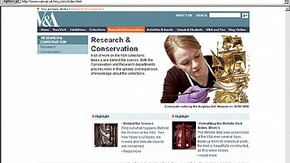
Figure 2: The top level link 'Research & Conservation', above the new Conservation front page (click image for larger version)
After discussion it was agreed I was to work on the Conservation webpages with the aim of inserting them into a newly re-designed V&A website, under the top-level link: 'Research & Conservation' (Figure 2). Due to time constraints, I was initially asked only to complete the biographical information for the staff pages ('People & Studios'). From the beginning I wanted to build an entire site, as a partial site would have little to offer when it came to publication. I now had only three months to complete the site.
I initially set up the site structure on a theme of two strands, interventive and preventive conservation. These actually quite controversial distinctions were used purely as a content guideline only. To ensure accessibility, the often very detailed information supplied had to be handled as broadly as possible. The Conservation Department Website Working Group, after some debate, chose the following titles for navigation of the site: People & Studios; Treatment & Care; Research; Training & Education; Advice & Access; Conservation Journal.
- The 'People & Studios' section (Figure 3) includes history of the Department and links to five pages describing each of the Conservation Department Sections: Paper, Book & Paintings; Furniture, Textile & Frames; Sculpture, Metalwork, Ceramics & Glass; Science; Management & Administration. Each of these pages includes a brief description of the studios. They also link to staff lists with specialisms and job titles. Staff names are clickable to individual pages, with photos and bibliographies.
- 'Treatment & Care' includes current projects. Houghton Hall is one such example, hopefully to have its own dedicated pages shortly. Work on objects in the Core Collection of the V&A is described here, as well as equipment and information on technique. This area could in the future provide information on couriering, surveying, condition reporting, storage, a conservation records database and possibly even the conservation of Museum 'highlights' from the past. Some of these processes are already described under the 'Behind the Scenes' link.
- Conservation 'Research', including Conservation Science, is often at the cutting edge and projects are frequently conducted in partnership with other organisations, described here with links to further information. A conservation glossary is included here as a separate link.
- 'Advice & Access' includes commonly requested documents such as the Ethics Checklist and the Environmental Policy. It also includes contact information and external links such as the ever popular Conservation Register, an external website providing information on private practice conservators. Treatment advice leaflets have been proposed for the future. The tours and events listed are generalised, more precise information being dependant on updating arrangements yet to be made.
- 'Training & Education' provides Continuous Professional Development information for Conservators, links to the RCA/V&A Postgraduate Course and information for prospective interns. Currently these pages contain general explanations and contact information, but in the future listings of internships actually available in the studios could be included here.
- The Conservation Journal has had its own area of the V&A website designed especially for it, post-secondment. I completed training on Rhythmyx - to be able to input the Journal and perhaps to contribute to the updating of the Conservation webpages - in September 2004.
Processes taken into consideration when building any website include site maintenance. Currently three of the webpages will need updating. The emphasis was on trying to make the published information initially as 'dateless' as possible, with the notable exceptions of current projects, ongoing research and forthcoming events. Procedures had to be put in place for the updating and submission of new content, including the staff pages. A Departmental Website Editorial Board has been established to oversee the content of the site. I 'signed over' the site for inputting into Rhythmyx on 31 January 2004.
Once content has been approved by the editorial board, it is input into the Rhythmyx database, usually by pasting it into specially designed page templates. Each page, image or other element is given metadata, i.e. keywords, to enable site searching. Rhythmyx provides the structure for the pages within the website (Figure 4). After a further review process involving both the Web Team and individuals in Conservation via email, the new information is cleared for publication as part of the V&A website. Rhythmyx will accept a range of media so there are options for using videoclips and other more interactive elements, at a later date.
The Conservation Journal is one of the first department-led pieces of information to go online via Rhythmyx. As various web projects are completed, ideas for other sites are suggested: Houghton Hall, the Mazarin Chest, the Ethics Checklist etc. An application for further Conservation-led webpages has just been approved.
The new V&A website complete with the Conservation pages under a top-level link, 'Research & Conservation', was launched on 31 August 2004 at: www.vam.ac.uk/res_cons/index.html
Issue 48 of the Conservation Journal was launched online in January 2005 (Figure 5). Ten of the most recent back copies are currently being processed. Issue 49 online should coincide with distribution of its printed version and Issue 50 will be a special celebratory event online as well as in print. The Online Conservation Journal is found at: www.vam.ac.uk/res_cons/conservation/journal/index.html
Acknowledgements
With grateful acknowledgements to everyone on the Web Team and Graham Martin, Head of Science in particular, for sharing my enthusiasm for this project so convincingly.
Summer 2005 Issue 50
- Editorial
- Rising damp - a history of the Conservation Department
- V&A Conservation on the world wide web: a secondment to the V&A web team
- The ethics checklist - ten years on
- Plastics preservation at the V&A
- Working for Diaghilev
- Pugin's wallpapers from The Grange
- Prevention is better than the cure
- Research
- The Castellani diadem
- In pursuit of a clear answer: An Exhibition Road partnership
- Investigation of the room temperature corrosion of replica museum glass
- Professional collaboration - the Prince of Wales Museum of Western India
- V&A/RIBA partnership
- Picture and mirror frames: Reflections on treatment past, present and future
- A simple solution?
- Appendix 1: Victoria & Albert Museum Conservation Department Ethics Checklist
- Conservation of a tortoiseshell book cover
- The hand that rocks the cradle: Conservation administration, present and future
- Printer friendly version
